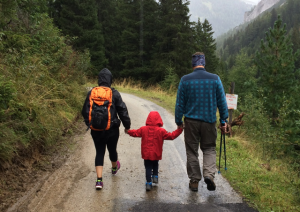Children do not come with a manual and there’s no formal training for parents. When it comes to having ‘those’ difficult life conversations, understanding how to broach sensitive topics can be a minefield.
Parents have to admit that they don’t always have all the answers. This is especially difficult when the life conversations are in an active, hot seat moment. It’s these important moments where a parent needs to be ‘on’ and their skills are put to the test.
It really shines a light on the fact that many parents are not merely ongoing role models which their children learn from nearly all the time. For the lucky ones, they are also seen by their children as mentors and non-ending sources of knowledge.
I want her to know the facts before she launches into something... I don’t know whether I’m right, but I know she listens to me.
Suzanne, Qual Interview
So, what subject matter dominates life conversations? Who owns them and when do they happen? Is there anything we can identify that has changed over time? Our Modern British Families research with News UK attempted to find out...
Diet and sugar is the new evil vs. smoking drinking and alcohol
In the 1980’s, many of the first life conversations between parents and children stemmed from a phrase on everyone's lips ‘Just Say No'. It echoed an anti-drugs message delivered by Nancy Regan, the US First Lady at the time, but was made popular in the UK by the teen TV soap, Grange Hill.
A song released by the cast reached number five in the charts and remained in the Top 100 for five weeks. It delivered a clear message, telling listeners to ‘Just Say No’ to drugs. Culture often pushed the questions, and they rose from a limited number of programmes with a captivated mass audience. Drugs, drink, and smoking were arguably the root of many parents’ nightmares and the topic of most life conversations at the time.
Fast forward to today and these children of the 1980’s are now parents tackling conversations with their own offspring. Today we have more questions being asked on more complex issues brought on in part by the role of platforms, such as social media and internet sites highlighting themes that raise further questions and then provide answers either rightly or wrongly. Added to this is the fact that more opinions are being sought beyond close friends and family.
When we asked parents what ‘life conversations’ were being had with their teens - the list was endless. There were several subjects that came up on a regular basis and were named as top areas of concern, including bullying, homosexuality, relationships, diet, happiness, and future plans. Notable was the absence of spontaneous mentions about smoking, alcohol, and drug abuse. Perhaps the latter are areas of less concern with this generation drinking less than previous and smoking at 13% penetration and a notable absence (especially in the pandemic) of the 1990’s headline grabbing fatalities of young people from drugs.
The focus of today’s government public health messaging is very different to that of the 1980’s. This appears to be reflected in the conversations parents are having with their teens. With obesity levels at an all-time high - one in five children classed as obese at age 11 and 37% of those 16-24 overweight or obese - diet and in particular sugar, has become the new enemy and arguably the grim reaper at the doors of our children.
Our survey data shows substance conversations are much rarer than other life conversations, with 37% of parents stating they have not spoken to their teen about taking drugs, drinking alcohol or smoking. This is in stark contrast to just 10% who have not had any recent conversations about their teens exercise habits and only 13% of parents have not spoken about their teens diet and eating habits. In fact, diet and eating habit conversations are frequent with over 60% of parents surveyed agreeing they’ve had three or more recent conversations about both diet and eating habits.
An economic picture which is colouring conversations
Job prospects and future career plans is another common topic of life conversation amongst families, with 42% of parents surveyed agreed they had discussed career and jobs more than five-times recently. These conversations are often triggered by the pressure felt within parent social circles as other parents reveal they’ve ‘done’ more in this space such as checking out colleges or career paths. This leaves some parents with a feeling they are ‘behind’ which spurs them to act and broach the conversation with their teen.
Despite worries about career prospects, only 48% of parents had managed three or more conversations about money and finance. This indicates that there is a lack of trigger moments and /or weaker confidence or knowledge to initiate this topic of conversation by either party. Many seemed to know it’s a thing they need to talk about but felt ill equipped practically, as much as emotionally, to deal with it.
Indeed, when we asked parents about these topics of conversation, they wished they’d had with their parents when they were a teen, one of the key themes that resonated with them was money. A stigma around money still seems to exist for many then - 40 years on.
The stigma around mental health has broken down but it’s still a difficult subject
Somewhat surprisingly our survey of parents shows that whilst parents know mental health is important, few know how to have the conversation with their children.
Unsurprisingly, it was one of the subjects they wished their own parents had discussed with them but only a half of parents have discussed mental health three times or more, indicating there’s an issue around knowing how to broach or talk about this area or they are lacking a trigger moment.
For some, the extended family are integral to who’s having these conversations
Grandparents cropped up more than once when we were talking to families about who teens have life conversations with. For some teens the one generation removed is a far more comfortable and open place for these trickier bigger conversations.
When it’s all about the trigger moment, less about an appointment to chat
Despite generational gaps, morals and values amongst families tend to be broadly aligned with all family members sharing concerns about the environment and economy (although strong opinions are much more prevalent amongst older vs younger teenagers).
Most of the conversation surrounds the differences between the generations at equivalent ages with the widespread acknowledgement that teenagers nowadays have a greater level of awareness and interest in world issues and a more proactive ‘activist’ approach.
He fobs me off a lot. I’ll go into his bedroom and try and have a chat with him and I get shoved off the bed, or “go away I’m doing this, I’m doing the other”.
Claire, Qual Interview
Many parents don’t plan life conversations, they just occur with the right trigger. Parents told us that a planned big and frank conversation is too pressured and too difficult to have. The more successful conversations stem from them being just part of the flow of conversation woven into the fabric of family life.
Parents told us of times which are ripe for triggering life conversations. The dinner table still is the key time for families to get together for family debates and lively discussion - as a side thought do also consider who has made dinner.
More than once we heard about older teens who have taken up cooking duties during lockdown whilst parents worked, and this is a contribution that teens intended to keep.
Dinner time is the time that we're nearly always all around the table. It's almost like anything and everything goes, whatever someone throws into the conversation mix.
Debby, Qual Interview
Another key moment for life conversations is when driving with only one child as the passenger. This was cited as an opportune moment for both parties to broach more sensitive conversations.
The side by side no eye contact approach was deemed a safe place to talk and often external stimulus on the journey was the spark to the conversation. For the same reasons, walking and jogging with a teen was also seen as a safe space.
How brands can be part of these new life conversations
1. Be conscious of your audiences’ daily life patterns
The time that falls between the gaps can become valuable. Think about where they are and who they are with. Drivetime radio or large outdoor could be the trigger at the optimum time to help them talk about tricky subjects such as mental health, money, or exercise.
On regular travel routes or time slots, brand narratives could evolve and play out seeding the message over time. For brands who want to be part of the conversation be there to trigger the conversation at the right moment.
2. Food remains a conversation starter
Mealtimes are still key opportunities for family conversations, consider what the new OXO moment could be for helping parents with conversations at mealtimes. Or finds a route that actively helps bring families together with food.
3. Don’t underestimate the power of the extended family
It’s probably time to rethink where the relationship with a brand starts. For example, what role do grandparents have on choice of savings accounts or financial plans for their grandchildren? Can a brand be a gateway for conversation between grandparents and grandchildren? In Sweden, McDonalds reinvented the classic Happy Meal for seniors. Instead of the traditional kids’ toy, they received a hand drawn creation from their grandchildren to help grandparents and their grandchildren connect during self-isolation.
4. Equip parents with knowledge and confidence
Some topics are easier to broach than others, some just fit into daily lives much more easily like diet and exercise whilst others are more sensitive like mental health and money. By equipping parents with the confidence to talk they can take
control of the topic and be the trusted voice.
Thus, drowning out any wrong misguided messages that can air so often on online platforms and amongst friendship groups.
Methodology:
News UK leveraged its reader panels (The Sun has 7,400 members and The Times has 14,200 members). Audiences with a child aged 12 or over were sent a 10-minute questionnaire in November 2020, asking about the role of the children in decision-making, impact of COVID-19 on family life as well as the types of conversation they were having with their children. The questionnaire received 202 responses from The Sun readers and 239 responses from The Times readers.









